Melaleuca penicula is a plant in the myrtle family, Myrtaceae and is endemic to the south of Western Australia. It is a rare species only known from the Fitzgerald River National Park and resembles Melaleuca eximia with its spikes of red flowers but its leaves and stamen bundles are different.

Melaleuca barlowii is a plant in the myrtle family, Myrtaceae and is endemic to the south-west of Western Australia. It is similar to a number of other Western Australian melaleucas such as M. conothamnoides with its purple pom-pom flower heads but is a more erect shrub with different leaves and the fruiting clusters have a different shape.
Melaleuca eximia is a plant in the myrtle family, Myrtaceae and is endemic to the south of Western Australia. It is distinguished by its leaf arrangement, its large, showy red inflorescences and the large, furry bracts under the flowers.

Melaleuca linguiformis is a plant in the myrtle family, Myrtaceae and is endemic to the south of Western Australia. It is a shrub with hairy new growth, small leaves and heads of white flowers similar to Melaleuca teuthidoides shorter sepals and more stamens in each flower.

Melaleuca strobophylla is a shrub or small tree in the myrtle family Myrtaceae and is endemic to the south-west of Western Australia. It has papery bark, sharply pointed, twisted leaves and rather long spikes of creamy white flowers in summer.
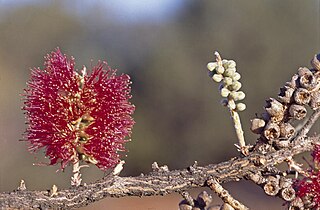
Melaleuca apostiba is a shrub in the myrtle family, Myrtaceae and is endemic to the south-west of Western Australia. It was first described in 1990 by Kirsten Cowley and remains a poorly known species. It resembles Melaleuca lateritia except for its hairy leaves and flower structures as well as its leaf shape and size.
Melaleuca xerophila is a shrub or small tree in the myrtle family Myrtaceae and is native to arid parts of South Australia and Western Australia. It is a large shrub with narrow leaves and heads of white or cream-coloured flowers in spring.
Melaleuca lecanantha is a plant in the myrtle family, Myrtaceae and is endemic to a small area of south-west Western Australia. It is a shrub with small, rather fleshy leaves and pink to lilac-coloured flowers in early spring. The plant was first described in 1867 but the name given to it was considered illegitimate and it was not until 1998 that it was first formally described.

Melaleuca camptoclada is a shrub in the myrtle family, Myrtaceae and is endemic to the south-west of Western Australia. It was first described in 1990 in a review of the genus Melaleuca when the species Melaleuca laxiflora at that time was found to comprise ten species. Two of those species were new - M. camptoclada and M. ctenoides.

Melaleuca ctenoides is a shrub in the myrtle family, Myrtaceae and is endemic to the south-west of Western Australia. It was first described in 1990 in a review of the genus Melaleuca when the species M. laxiflora at that time was found to comprise ten species. Two of those species were new - M. camptoclada and M. ctenoides. It similar to Melaleuca laxiflora but distinguished from it by its comb-like leaves and attractive mauve or violet flowers in spring.
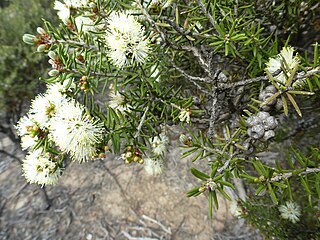
Melaleuca pauperiflora, commonly known as boree, is a plant in the myrtle family, Myrtaceae, and is native to the southern parts of South Australia and Western Australia. It is distinguished by its short, thick leaves and small but profuse heads of white or cream flowers. There are three subspecies.

Melaleuca pomphostoma is a plant in the myrtle family, Myrtaceae, and is endemic to the south-west of Western Australia. It is a small, dense shrub with fleshy, narrow leaves, greenish-yellow flowers. It is similar and closely related to Melaleuca bracteosa but differs in the colour and number of stamens in each flower.
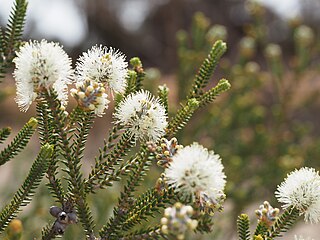
Melaleuca quadrifaria, commonly known as limestone honey-myrtle, is a plant in the myrtle family, Myrtaceae, and is native to the south of Western Australia. It is distinguished by the small size and arrangement of its leaves combined with its small spikes of white or cream flowers.
Melaleuca sciotostyla, commonly known as Wongan melaleuca, is a plant in the myrtle family, Myrtaceae, and is endemic to the south-west of Western Australia. It is an endangered species with only 476 mature plants known in 2001. It is closely related and very similar to Melaleuca haplantha but has narrower leaves and fewer stamens per flower than that species.
Melaleuca sculponeata is a plant in the myrtle family, Myrtaceae, and is endemic to the south-west of Western Australia. It is a small, rare shrub with fleshy leaves and white heads of flowers.
Melaleuca subalaris is a plant in the myrtle family, Myrtaceae, and is endemic to the south of Western Australia. It is distinguished by its small, decussate leaves and small flower heads which rarely have more than one flower in each inflorescence.

Melaleuca teuthidoides is a plant in the myrtle family, Myrtaceae and is endemic to the south of Western Australia. It is a shrub with rough bark and heads of white flowers on the ends of its branches in spring and early summer.
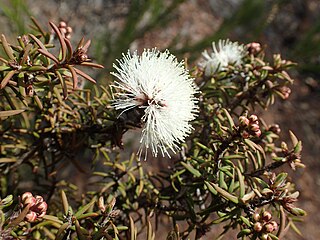
Melaleuca torquata is a plant in the myrtle family, Myrtaceae and is endemic to the south of Western Australia. It is a prickly shrub whose leaves have a distinct mid-vein on the lower surface and which has heads of pinkish white flowerheads in early spring.
Melaleuca calcicola is a plant in the myrtle family, Myrtaceae and is endemic to the south of Western Australia. It was formerly known as a subspecies of Melaleuca apodocephala but was reassessed in 2010 and raised to species status. Its branches are corky, the leaves pointed although not prickly and the flowers are creamy white, tipped with yellow.
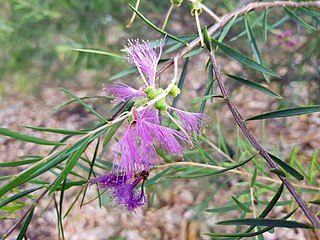
Melaleuca fulgens subsp. steedmanii, commonly known as the scarlet honey myrtle, is a plant in the myrtle family, Myrtaceae and is endemic to the south-west of Western Australia. In 1990, the species Melaleuca fulgens was separated into 3 subspecies. Of the two subspecies occurring in the south-west, this one has the narrower distribution, occurring mainly near Geraldton. As with the other subspecies, this one is notable for its showy flowers which are usually red but its foliage and fruits are also attractive features.













